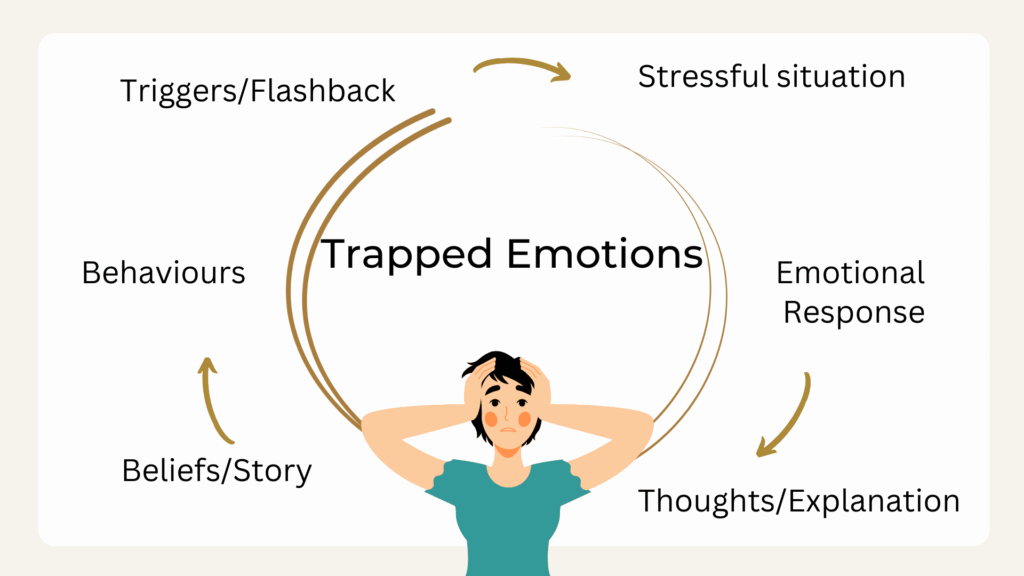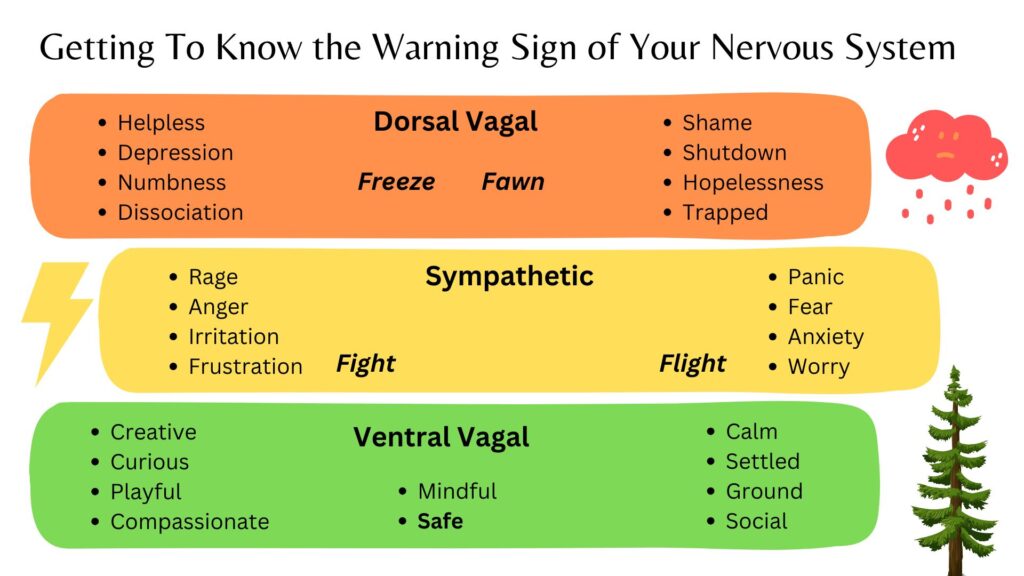We are human, and that means we feel emotions constantly. How connected we are to them differs from person to person. Some people are very disconnected, and don’t feel their feelings unless they are in extremely intense situations, while others get bombarded with intense emotions throughout the day. The key is to find a way to feel your emotions, be with them and allow them to move through you.

The Focusing technique is a great way to learn this process. It’s a way to be with a felt sense, name it and see if it needs anything. This shifts you to being in relationship with your emotions instead of trying to avoid or change them. When we have this relationship to our emotions, they become less scary and intimidating. However, if you struggle with triggers and flashbacks this is easier said than done. It’s important to understand the difference, so you know where you are at and what you need at the moment.
A trigger is the initial situation, environment, or action that causes your body to set off an alarm because it’s similar to a past trauma or past stressful experience. Whereas a flashback is the state your body goes in, the emotions and feelings that were connected to that past experiences or similar experiences. You will also see a change in your thinking; the stories you are telling yourself while in the flashback will be connected to the past. Then, of course, being in this state affects your perception of the current situation because you feel like you are in the past. These feelings, thoughts and emotions feel real and you may not be able to decipher the difference between the past and what is happening in the present moment. For example, you might find ways to justify your anger and what someone did to you instead of being able to see the bigger picture of the situation and your role and that it’s not what happened before.
The cycle of trapped emotions
When we have an experience it brings up a felt sense or emotion in our bodies. Emotions are energy that then get interpreted and create feelings like sadness or anger. If you are in a stressful situation you will have an emotional response to it. You then begin to interpret that situation and create an explanation. This over time develops into a belief or story you tell yourself and you end up acting based on that story or belief. When you are in a similar situation, you will be reminded of that past situation since you did not release that stressful energy. Like animals we need to literally shake it off and process the energy that came up in a stressful or traumatic experience. We have to complete the cycle to return to calm.

What Sets you Off
It’s important to know what sets you off. This goes for practical things like not drinking enough water to knowing what situations are too much for you, emotionally and energetically. If you are dealing with past trauma it’s important to slowly face those situations so that you can differentiate the past from the present. Learning and practicing different techniques to release trapped emotions, like somatic experiences, focusing and EFT tapping can be very helpful in overcoming emotional overload.
Paying more attention to the sensations in your body and your overall felt sense throughout the day is a game changer to knowing what you need at any given moment. The more you can meet your needs, or when not possible, at least accept that they are there, will help you be more emotionally balanced. Consider what you need to pay attention to both internally and externally so that you can stay grounded and present.
Internal Signs
- Not enough water
- Lack of sleep
- Hungry, Angry, Lonely, Tired (HALT)
- Past situation
- Lack of connection to your emotions
External Triggers
- Someone yelling
- A particular person
- Asking certain questions
- Certain environments
- Social situations
- Past relationships!!!!
Connecting to your body and the present moment
Take some time to look at the diagram below. Do you notice a certain type of feeling that you experience regularly? Is there something that sets it off? Getting back to ventral vagal is key to feeling more grounded and like yourself. Start thinking of ways that you can pay attention to what state you are in at any given moment to help you be more connected to your body and what you need.

Daily Practices
When I work with clients, we establish daily practices that help build resilience and alongside these daily practices we build a tool kit when things get intense and emotions run wild. Having daily practices makes it easier to use a familiar tool when things get overwhelming. See which practices make sense for you and build your daily routine:
Breathing
Breathing techniques help calm the nervous system and communicate to the brain that everything is ok. They also help you stay more connected to your body and the present moment. Keep in mind that they take time to practice and it’s ideal to do them for at least 2 minutes to feel the effect. This is why it’s important to practice them daily and when you are feeling good in the moment.
- Breathing with movement
- Woah
- Woooo
- Om
- 4 count in 6 count out
Ventral Vagal Rest
There are so many wonderful techniques that help your nervous system reset and get you back into ventral vagal. Below are some that you can try out or you can check out this video playlist for some more.
- Deep breath in, another small breath in and then sigh it out slowly from your mouth
- Ear massage
- Shaking + breathing deeply in and out
- EFT Tapping + Body tapping
- Fist tapping on lower abdomen
Movement
I can’t tell you how important and powerful it is to move our bodies. A significant amount of people’s anxiety is due to lack of movement and stagnant energy from sitting too much. Make it a point to move throughout the day, even for just a few minutes every hour. Try to integrate the following into your daily practice or any other favourites you may have.
- Flow Yoga
- Yin Yoga at night
- Chi Gong
- Thai Chi
- DANCE!
- Go for a walk, try barefoot as well
Nature + Grounding
Feeling your body and being grounded is so important to emotional regulation. When we are not lost in our mind, we feel our body and can listen to what it needs. Nature and other healing practices can help you stay connected and grounded in yourself and the present moment:
- Walking in nature
- Hug a tree
- Go bare foot!
- Acupuncture
- Stomping
- Shaking
Co-regulating activities
Over the years we’ve become more and more isolated as a society. Unless you are well-and deeply connected to a community, family or friends, you will notice that you have a lot of anxiety. That’s because as humans we co-regulate each other. Surrounding yourself with positive, well-rounded people will automatically ground and calm your nervous system and support you in having a positive sense of self.
- Spiritual group
- Sport
- Creative group ie. writing
- Dancing
- Song circle
Intentional Time
It’s important to balance connection time with others and with yourself. What do you do each day to take some time to quiet down and slow down so you can check in and reflect?
- Journaling
- Reading or listening to a book – learning
- Meditation
- Mindful moments
Remember, whether you’ve had a challenging past or not, it’s important to develop daily practices to build resiliency and stay connected to yourself. Having these practices will also make it less scary to feel your feelings, especially when you see them as a part of you that needs your attention. Creating this rhythm will allow you to show up in the world the way you want to instead of being thrown off and behaving in a way that doesn’t really feel like you.

